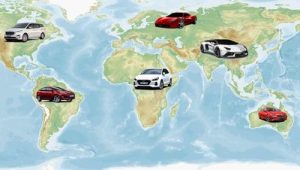Globalization of the automobile industry:
The automobile industry aims to attain high competitiveness through technology transfer and active innovative learning, as one of its development vectors is innovation. Globalization of the automobile industry is affected by technological factors, so bear that in mind when developing and implementing the company’s creative technology transfer plan.
Thailand’s car industry appears to be a success story; it makes a substantial GDP contribution to the nation and has been known as Southeast Asia’s “Detroit of auto manufacturing.” Thailand is a top automotive manufacturing centre, home to Nissan, Toyota, and Ford.
The Thai automobile industry’s growth depends on the performance of global businesses, thus it’s unclear if it could keep the same position with just its own technological capabilities. The Global Automobile industry is growing rapidly.
The Big Three:
The country’s economy is greatly impacted by the success of a wide range of firms that are required to function in mass production due to the size of the car sector. The worldwide automobile sector has changed throughout the past century, from the 1910s to the present. The Big Three (Ford, General Motors, and Chrysler) had dominated the American auto industry since the 1910s, Europe began to emerge in the 1960s, and automotive manufacture first began in Europe.
It is essential for developing countries to absorb innovations from more developed countries in order to close knowledge gaps and transform economic development into creative capacities.
Newly Industrializing Economies (NIEs):
Back to Global automotive industry 2023 may be very nice but In numerous developing countries, such as Thailand and South Korea, the automobile industry has evolved over the past 60 years from an agrarian to a rapidly growing manufacturing sector. Thailand and South Korea lacked the necessary technologies when production began. In both nations, governments have been vital to the growth of the business. Korea used to be a country that was playing catch-up, but its automobile industry has risen rapidly. Now, it is a major producer. The South Korean automotive industry has demonstrated its ability and willingness to manufacture its own automobiles. Korea’s pursuit and devotion to a distinct, autonomous strategy led to the growth of the country’s automobile industry.
Regional companies:
The independent strategy protected regional companies and kept international multinational corporations (MNCs) out of the market. The government engaged in research and development (R&D) to create new products, but it rejected management control in a joint venture with multinational corporations (MNCs). South Korea has been among the top ten automakers in the world for the last 20 years.
The term “innovativeness” is most frequently used to describe how “new” an innovation is.
Technology leads to innovativeness:
We suggest that the process of learning technology leads to innovativeness. In the end, there are three sources of technological knowledge: domestically, internationally, and internally. South Korea received technology from a foreign source by trading stock shares for technological access. For example, Hyundai donated Mitsubishi Motor 12 percent of its shares and Kia gave Ford 20 percent in exchange for access to the technology. Conversely,
Daewoo’s joint venture with General Motors had an impressive debut. But without management oversight, Hyundai is unable to produce its own goods to meet consumer demand. Daewoo’s performance increased as they adopted an autonomous approach. Similar to what happened with Daewoo, joint partnerships with foreign multinational firms limit Thailand’s success.
Demand for automobiles:
Even though there are currently very few Chinese people who can afford cars, there is expected to be a sizable future market for cars in China. Globalization in the automotive industry – impact and trends, the first half of 2002 saw an extraordinary surge in demand for automobiles, with sales rising by an incredible 40% over the same period in 2001. Even with a rise in sales over the preceding two years, Chinese individuals still only own 1.5% of all cars worldwide, although making up 20% of the global population.
Suggested to Read: Life Insurance Companies in Europe
In contrast to other nations, 5% of the population in the United States owns 25% of all cars worldwide. Put another way, China currently has about the same per-capita automobile ownership as the United States did in 1913.
The expansion of the automobile sector was hampered by the Great Leap Forward program (1958–1960) and other national government initiatives. Chinese authorities sought to encourage small-scale industry across rural regions, while Globalization of the automobile industry American and European automakers combined businesses and employed mass production methods.
Self-sufficiency:

Launched in 1964 as a continuation of the Great Leap Forward, the “Third Front” plan aimed to develop an interior military
and industrial base and promote self-sufficiency. Motor insurance quote During these years, heavy industry was dispersed around the country in an attempt to fortify industrial defences against potential attacks and prepare for a potential war. In 1969, there were thirty-three auto plants, totalling 150 car production facilities.
Many of the Third Front’s car factories are still in operation today. One such example is the well-known Shiyan Number Two Automobile Factory in Hubei province, which is now known as Dongfeng Automobile Company.
Modern technologies:
Modern technologies are used in every stage of the manufacturing of an automobile. Numerous structural advances have resulted from the demand for better vehicle performance, safety and crashworthiness, and reduced environmental effect. Unibody technology had largely supplanted entire frame designs utilized in car body manufacture by the 1980s.
Modular composite designs and spaceframe-based designs have also been observed more recently. Globalization of the automobile industry the cars now depend more on electronics and less on mechanics in addition to this shift. Modern cars are now controlled and monitored by a variety of electrical systems, electronic sensors, and actuators that have “taken over.”
Electronics navigation:
Electronics used for navigation system operation, entertainment units, and troubleshooting and diagnostics. Approximately twice as many electronic components are found in cars create even ten years ago as in cars built now. Moreover, they may represent as much as 35 percent of the car’s overall cost. Electronics has not only played a significant role in the evolution of the engine and powertrain, but it is also crucia.
You may also like: Insurance its Importance and Types
But the automotive revolution is far from over, as fuel cells and hybrid vehicles are expected to hit the market before the end of the decade.
Online sales:
New technologies are also having an impact on the way the automotive industry does business. Although only five percent of automobile transactions were conducted online in 1999, up to forty percent of US new car buyers used the Internet at least once to research the vehicle they were purchasing. Online sales are expected to grow significantly in the next years. There are also changes occurring at the supply chain level. With the recent announcements
from Ford, General Motors, Daimler Chrysler, Renault, and Nissan to join their e-commerce projects, the auto industry is entering a new phase of supply chain management.
Volkswagen has already stated that it will create a similar online marketplace for its suppliers, and all other major automakers intend to either participate in the existing exchanges or establish their own. In April 2021, six of the largest auto suppliers said that they would work together to study online strategies with the goal of establishing their own e-marketplace.
Passenger cars:

In 2024, passenger cars may be ship about 20 countries. With export volumes of roughly one million cars, Mexico, the Czech Republic, Slovakia, and Spain rank second and third, respectively, in terms of export volume. With more than 2.5 million net yearly sales of automobiles internationally, Germany, South Korea, and Japan stand alone in the automotive industry.
Where foreign commercial relations are widespread, there is a complex topography. At the same time, to Globalization of the automobile industry a distinct regional division of labor has emerged at the level of global regions such as Europe. In these locations, there is a hierarchy between the periphery, which concentrates on production-related activities, and the core areas, which house MNC headquarters. Importantly, R&D for vehicle development is typically concentrate on manufacturing support in peripheral sites, while automakers and international suppliers typically establish their core R&D facilities in these places.
To cut labour costs:
To cut labour costs, OEMs move assembly and production to the periphery. Among the Big Three is Ford Motor Company, the second-biggest automobile manufacturer in the world. Many new suppliers, including those from South Korea, Mexico, and Spain, were able to successfully enter the international auto markets. In less than 10 years, the countries depicted in almost doubled their export share. Accounting for roughly a quarter of all vehicle exports worldwide in the second half of the 1990s.
international market:
Brazil has traditionally restricted the sale of its cars to regional markets. But it is anticipate to become increasingly focuses on the international market. How to donate a car in California may be a good question for all. According to investment efforts that have been in place since the mid-1990s. Automakers are modifying their business strategies in response to Brazil’s liberalized import rules.
Automotive inputs:
In terms of the US automobile industry, engines, electrical machinery, and other parts and accessories were increasingly import from Mexico. The primary, if low-income, providers of automotive inputs to the Japanese auto industry were other Asian countries. Since the mid-1990s, this industry has been importing an ever-increasing proportion of engines from countries in Central Europe. Automotive warranty also good. Based on the percentage of imports from important low-income trading partners in overall imports of automotive inputs. The competitive pressure from below appears to be equally advance in all three of the traditional producing countries. However, the total amount of imports contributed much less to domestic production.
Ending words:
The evidence points to a growing pressure from new locations in low-income countries to compete with existing car-producing nations. Mexico, Spain, and the Czech Republic are now attractive suppliers of complete cars and vehicle parts. Other nations, such as Korea, concentrated on entering the global markets for completed autos. Even though Japan imports of automotive inputs were fewer than those of the US and Germany. Three traditional production nations were nonetheless impacted.
 ETVTIME This is Knowledge Time
ETVTIME This is Knowledge Time
